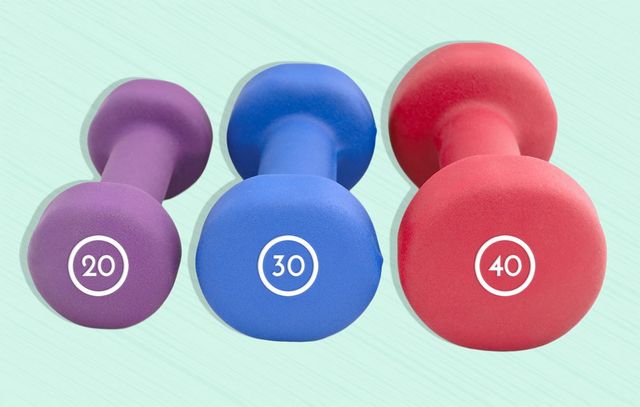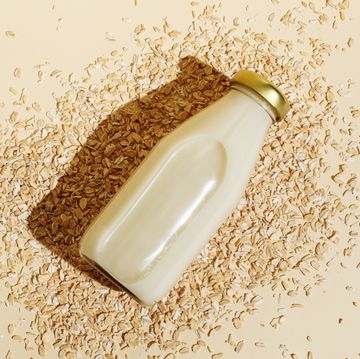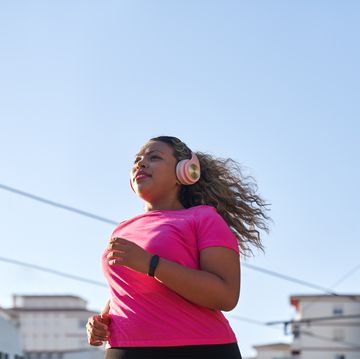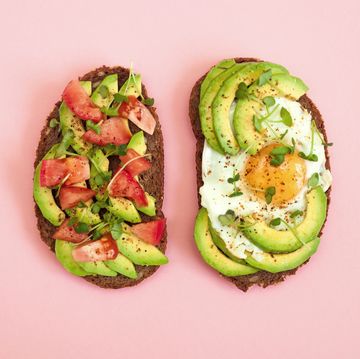When it comes to fat loss, your workouts are anything but timeless. Over the decades, what you need to do get (and stay!) at a healthy weight changes. And, spoiler alert, it gets more challenging.
But exactly how tough it becomes depends on exactly how you decide to attack the pesky poundage.
Follow these tips for faster, easier results, whatever your age.
At this point in their lives, a lot of women gain weight for one simple reason: They're sitting in offices. All. Freaking. Day. Research from Northwestern University shows that even women who exercise on the regular still sit way too much.
While you’ve undoubtedly heard the whole 10,000 steps per day recommendation, for weight loss, it’s more important to increase your step count from week to week than it is to hit one specific step goal. Try setting a goal you know you can reach this week. The next week, bump up that step count by 1,000. Keep up the step goal setting and slaying and you'll be on your way to losing weight in no time.
Any great weight-loss program should include both cardio and strength training, but the younger you are, the more effective cardio is for losing weight. That’s because your levels of lean muscle and your metabolic rate are as high as they will ever be in your 20s.
Try performing high-intensity interval training (HIIT) and strength circuits. Both are great for blending strength training and cardio into one efficient workout. Plus, since your body is primed for recovery in your 20s, you’re less likely to risk overtraining.
RELATED: THIS TOTAL-BODY MOVE TORCHES FAT AND BUILDS MUSCLE AT THE SAME TIME
Pregnancy doesn’t have to (and usually shouldn’t) mean time away from exercising. When you’re pregnant, your caloric needs only increase by a few hundred calories per day, so if you’re eating more than that, staying active can help you keep your weight in check. (Although it's worth noting that you can’t out-exercise a bad diet.)
What’s more, one comprehensive research review, published in the journal Women's Health (no relation to us!), shows that exercising before and during pregnancy can help prevent gestational diabetes. And that's great because gestational diabetes significantly increases your likelihood of developing Type 2 diabetes later on. Meanwhile, exercising after you give birth can help you lose some pregnancy weight.
If you are pregnant, trying to get pregnant, or have recently given birth, talk to your ob-gyn and a certified trainer to make sure that your workout fits your body’s unique needs.
Try these easy yoga moves for weight loss:
Building muscle in your 20s was important. But now it’s non-negotiable. Starting around age 30, women’s muscle mass naturally begins to decline—up to 3 to 5 percent per decade, says Wendy Scinta, M.D., president of the Obesity Medicine Association. She says that if you keep doing the same workouts in your 30s that you did in your 20s, you will gain weight. That's because your lean muscle mass is the main driver of your metabolism.
Research from Harvard University shows that, minute per minute, strength training is better than cardio at preventing age-related belly fat. (Learn a special strength training program designed specifically for women.)
You can combat the drop in muscle and metabolism during your 30s by increasing your focus on strength training. And when you're in the weight room, try performing three to five sets of six to 12 reps of any strengthening exercise. Your weight should be heavy enough that you're just able to eek out the last rep with perfect form. Prioritize big, compound lifts such as squats, deadlifts, and pullups.
RELATED: 5 STRENGTH-TRAINING TIPS TO REV UP YOUR WEIGHT LOSS
To effectively build calorie-torching muscle at the gym, you need to increase your protein intake—especially as the decades pass. That’s because the body actually becomes less sensitive to protein as you age, meaning you may need to eat more to get the same muscle-building effect.
To combat muscle loss, research from the University of Arkansas for Medical Sciences recommends aiming to eat 1.5 grams of protein for every kilogram you weigh per day. So if you weigh 160 pounds (about 72 kilos), that equals 109 grams per day. Similarly, research published in Applied Physiology, Nutrition, and Metabolism shows that eating 25 to 35 grams at each meal is best for losing weight while retaining muscle.
Your body doesn’t only get stronger and fitter during your workouts. It does that as you recover. Unfortunately, that process begins to take longer in your 40s.
Adjust your routine by working certain muscle groups on certain days. For example, if you're working out four or five days per week, make Monday a lower-body day, Wednesday a chest and triceps day, Friday a back and biceps day, and then get some steady-state cardio on Saturday and/ or Sunday. By structuring your workout that way, you can give your muscles some extra recovery time without having to cut back on your gym time or results.
Your hormones tend to go crazy during both perimenopause and menopause, which can lead to weight gain, especially around the middle. Luckily, a 2015 study shows that strength and endurance workouts can help you lose weight by promoting healthy hormone levels.
But for some women that’s not enough, says Scinta. While low estrogen levels can contribute to weight gain, testosterone deficiencies can make it harder to build muscle and boost your metabolism, she says.
RELATED: HOW TO TURN OFF YOUR WEIGHT GAIN HORMONES
If you experience symptoms from too-low levels of estrogen and testosterone following menopause, like weight gain (duh), acne, thinning hair, loss of libido, and severe hot flashes and vaginal dryness, talk to your doctor about having your hormone levels checked. Once you shore up any potential hormone imbalances, you’ll be able to get more out of every workout.
K. Aleisha Fetters, M.S., C.S.C.S., is Chicago-based certified strength and conditioning specialist, training clients both in-person and online.













